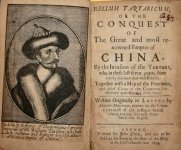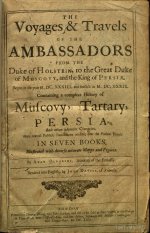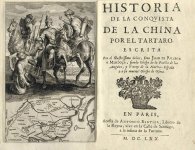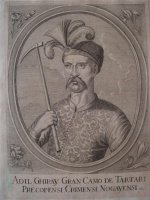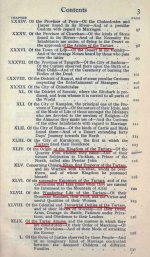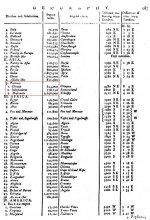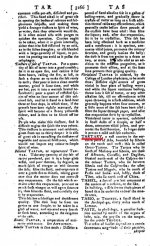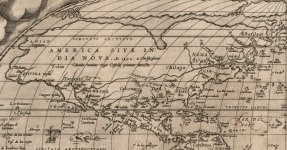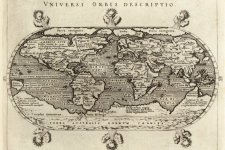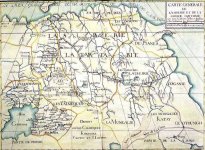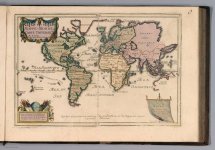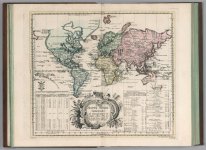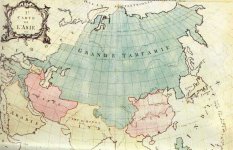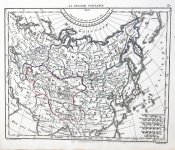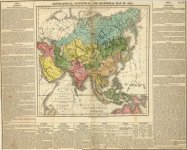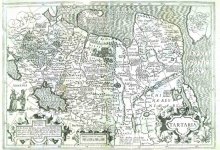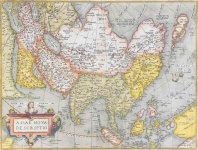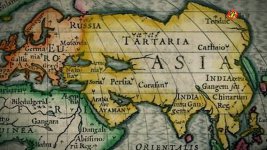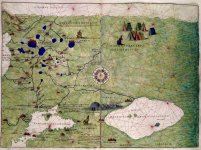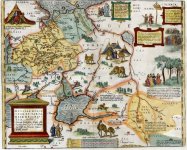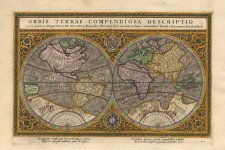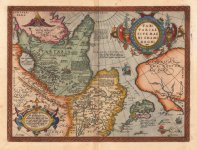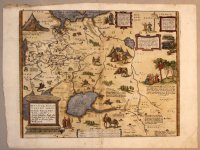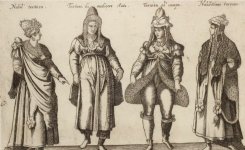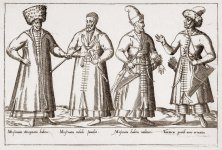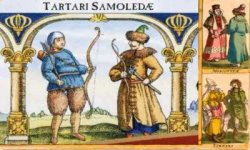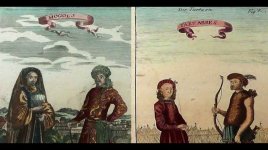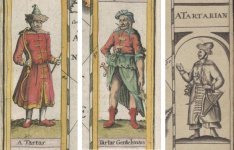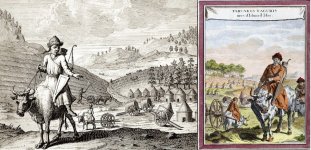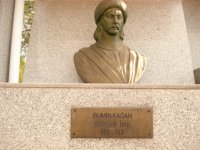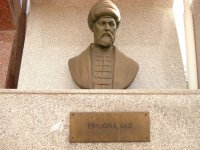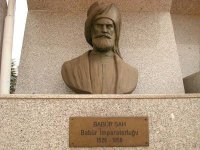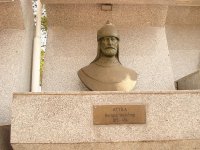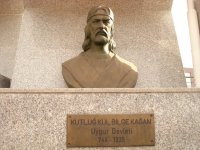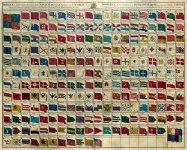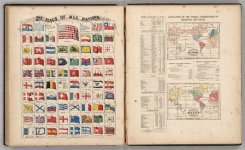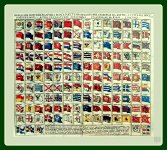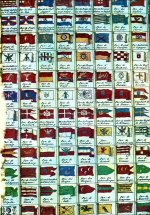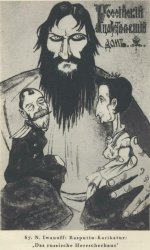Here is an English Transcript o AISPIK group YouTube video “History of Great Tartary - Part 9.XIX century. War again. Flood again. #AISPIK”
Its mostly Babylon translation – I edited it a bit but you will get the main hypothesis of this researcher. He does a lot of work to formulate them and tries to put together missing pieces of our history the same way he did when he worked as a criminologist.
“The existence of ancient and other civilizations still unknown to science will be presented and recognized very soon. During the existence of these civilizations, physical laws and constants were different than they are now. Even without taking into account another worldview, this alone makes it very difficult to interpret the traces of other civilizations. I ask you to highlight this: when the dynamics of physical laws and constants is recognized and investigated, then many artifacts will become understandable.” Serkin V. P. Bolshaya Kniga Shamana. In Russian/ Serkin In. P. Great Book of Shaman. In Russian, 2019, Moscow
Hello. You are back on the AISPIK Alternative History of the Northern Black Sea and Caucasus Channel. With you, I am its author - Oleg Pavlyuchenko. With this film I continue the Project – The History of the Great Tartaria. And today we will consider the events taking place in the Russian Empire and in Europe in the first half of the nineteenth century. To reconstruct these historical events, I studied a huge amount of information on the Internet, read a lot of literature and as usual I made my Analytical review of the beginning of the first half of the middle of the 19th century that led to a new planetary Catastrophe. [Note: Oleg Pavlyuchenko is a criminologist. His research is quite meticulous and thorough. His research is not only literary – his group conducts its research on the site of the recent catastrophes of the 17th and 19th centuries, using different scientific methods].
But first, I'll remind you a little bit. The events that we considered in the previous part of the project is the history of the Great Tartary. In particular, this series we called Russia against Europe. According to my theory of which I expressed in this part of the Project, Russia which was an integral part of that very Europe as a province of transcontinental Kingdom of Kingdoms (Great Tartary), after the War of 1812, began its own separate path. This Path did not coincide at all with the paths taken by the European states. Or rather the Core of European states. Why didn't this path coincide? Because Alexander the First, won together with Austria and Prussia, the Catholic Napoleonic European Union. Austria and Prussia were Protestants whose goal was to limit the monarchy and bring the bourgeoisie to power. So, Alexander the First did not want to limit his monarchy to the bourgeois parliament and began to play his game. His father Paul the First, unlike his grandmother Catherine, who was also actually on the side of the Protestant bloc, was a Catholic and a member of the Order of Malta, and advocated absolute monarchy in Russia. So, Alexander the First, with the help of Protestants and with the help of closed Protestant clubs, overthrew his father and had to play the Protestant game. But having seized Europe, apparently feeling his strength, Alexander tried to get out from under Protestant influence. But as we now understand it, he did not succeed. And in order to protect himself, and most importantly to secure his power based on the nobility and absolute monarchy, he had to choose his own path for Russia. And it was Alexander the First who chose for Russia this own path of absolute monarchy based on the nobility. The class that is completely dependent on the Monarchy and at the same time will not allow industrialists and capitalists to power, that is, to manage the state. Alexander planned to grant all government sits to the nobles, while the capitalists would have nothing to do with state power. But Protestant Europe took a completely different path. After numerous so-called Napoleonic revolutions, the purpose of which was the Protestant restriction of the monarchy and the introduction of a parliament of capitalists and industrialists - that is, the bourgeois class. Europeans completely excluded the power of monarchies and nobles [I would argue it as it was not ‘excluded’, it was put out of site of public – Queen still has allodial ownership of dominion lands]. Only those who merged with the capitalists remained. The Catholic model implied only an absolute monarchy based on nobles and industrialists. Of course, for the chosen own path of Russia, Alexander the First paid a rather serious price. First, he had to leave the Europe he occupied. Also, I think the allies abandoned him. And imagine after the victory over Napoleon in all European capitals sat Russian governors-general. Intrigues began. And power in Europe was difficult to keep. Alexander left Europe to the Protestants, who immediately began Revolutions in Catholic countries limiting monarchies. Countries such as France were actually Protestant, but under the flag of Catholicism. Plus, there was a split among the Protestants. England and Holland became one pole, and Prussia the second. So, for almost a century we have always seen a dispute between England and Germany. But that's another story. And as I've said in previous Series, Protestantism is governed and regulated through closed clubs. There are English Freemasons and there are German Freemasons. A constant dispute between England and France passed through the confrontation of Masonic lodges - the German Rosicrucians and the English Illuminati. But Freemasonry is not a governing body, it is an organization similar to the Soviet Communist Party. To achieve something, you have to be a member of the party. Protestants - former allies of Alexander the First, who helped overthrow his father decided to take revenge on him. Alexander left Europe and closed in Russia. The Protestants, through the fifth column, were preparing a bourgeois revolution in Russia. As a result, there was an imaginary death of Alexander the First. Alexander went east to the third force, renaming himself to Fyodor Kuzmich. He prepared Nicholas I as a successor of his ideas. Pro-catholic Constantine, who was in Poland, was pushed out of power. The fifth column in the form of the Decembrist Uprising was defeated. In my opinion, the decision of Alexander the Great to go into the shadows is most likely due to the fact that a new figure was needed for the management of Russia, not bound by a treaty with the Protestants. At the same time, Alexander simply remained in the shadows and most likely lived out his life as Fyodor Kuzmich. And Nicholas was no longer bound to anyone by any treaties. Nicholas led Russia along his own path and this path was, in my opinion, a symbiosis between the absolute monarchy of the nobles and industrial/financial capitalism, which was formed without much participation of Western capitalists. The rise to power of Protestants in Europe caused a huge industrial boom. Of course, in contrast to the European industrial rise, the Russia, too, began the industrial boom of the 30s of the nineteenth century. But this Russian boom was certainly different from the European one. First, it was based on national developments. Secondly, most likely in the Russian industry was directly involved Moscow Tartaria with its capital in Tobolsk. After the catastrophe of the 17th and 18th centuries, which destroyed most of the territory of Tartary (or the Kingdom of Kingdoms, which covered the entire planet with a single architecture and technologies superior to our civilization and to the inter-flood civilization of the 17th-19th century - so-called by Oleg Pavlyuchenko, the Steampunk civilization (with wireless electricity etc...) which also surpassed ours. The history until the middle of the 19th century was completely falsified). After 17 century catastrophe, a huge number of the population of the center of Tartary from the Regions of the Sea of Okhotsk, Chukotka, such cities as Kambalu, Tyndyuk, Mogol, Tartar - moved somewhere to the Altai and Tibet. But in Tobolsk there was such a state called Moscow Tartaria, which most likely was subordinate to the new Altai-Tibetan center of Great Tartary. Moscow Tartaria had a tsar in Tobolsk. But more on that later. Moscow Tartaria most likely saved Alexander I from the massacre of Protestants. As we understand Alexander the First under the name of Fyodor Kuzmich lived at one time on the territory of Moscow Tartary. Moscow's Tartary was not very crowded, but had remnants of technology and knowledge that helped it to include Russia in the sphere of its interests. In fact, Tartary saw Russia as an ally. And in the future, according to its plan for the restoration of lost positions, apparently it was supposed to fully include the Russian Empire in its Tartary lands. So most likely the Moscow Tartaria was the source of Russian technologies. And it was the Cherepanov brothers who invented the locomotive. The first railway was built/or excavated in Nizhny Tagil, which in the late 18th century was part of the territory of Tartary rather than the Russian Empire.
Now back to the Tsar of Moscow Tartary. As you understand, Tobolsk was the capital of Moscow Tartaria.
The Tsar who was there was not Nicholas the First. The researcher Sergei Ignatenko explained it quite well in his YouTube film 'Witness to an unknown catastrophe in Russia in the mid-19th century' Sergei tells: I decided to do my own investigation and found the following materials. During the years 1840-1843 from the city of Tobolsk received decrees on behalf of his imperial majesty the autocrat of All-Russia. Here is this electronic version of this print of 459 pages with orders decree of His Imperial Majesty the autocrat of the all-Russia.
We see various signatures here. Basically, all the decrees related to the search for various people of the peasants, the nobles and so on. Everywhere the same thing - the signature of the decree of His Imperial Majesty. Officially, the presence of Emperor Nicholas I in Tobolsk at this time is unknown. A legitimate question arises. Either the emperor was always in Tobolsk, or the decrees came from another emperor, that is, not from Nicholas the First.
Oleg Pavlyuchenko AISPIK continues: And another image of that time is the climate. The climate was very different, not as completely as it is today. Of course, not the same as it was before the catastrophe of the 17-18 centuries. But not the same as it became after the catastrophe of the mid-19th century. It was certainly much warmer than it is now. And indeed, on Solovetsky Islands were still making wine. In the Arkhangelsk region, bread was grown. In the "fierce winters", judging by the clothes from the Hermitage - people walked in light jackets. And the territory of Siberia most likely represented the image that we draw pictures of Russian artists who painted Russian landscapes.
As we can see from the YouTube film by Sergei Ignatenko in Tobolsk lived more than a million people. Now there are not so many people who live there, even at the level of modern technology. That is, Tobolsk was in a completely different climatic zone. We also know about the climate that the atmospheric pressure was twice as high. This conclusion has been made by many researchers. And if the pressure is much greater, then accordingly the heat exchange - the atmosphere is completely different. Thermodynamics suggests that in denser air the heat is retained much easily. And there was no such a drastic change of climate between winter and summer. Although the Earth axis has already been deflected by 23 degrees. Now the planes of the ecliptic are deflected somewhere on the order of 20 degrees. And the North Pole was no longer where before the First Flood of the 17th and 18th centuries - in Greenland.
The pole before the catastrophe of 19thc century was in the place that we reconstructed in our project 'Three Poles Two Floods'. After the first catastrophe of the 17-18 centuries, the pole jumped to an intermediate place on the surface of our planet. But after the disaster from the middle of the 19th, it moved into the current place. But this intermediate place from the modern place practically does not differ in latitude. It only differs by only three degrees. However, the climate of the beginning of the 19 century was different because of the density of the atmosphere. Now as for the technological level of inter-flood time - between the end of the 17th and beginning of the 18th century - the moment of the first catastrophe and the middle of the nineteenth century - the moment of the second catastrophe. So, the technological level was absolutely not what the falsifiers of history are now drawing for us. This question has again been studied by many alternative researchers.
In the inter-flood time, atmospheric wireless electricity was used on different principles than now. And this is very clearly seen in these drawings. And the weapons and uniform of the Hussars of the soldiers of time until the middle of the 19th century practically did not allow to fight in this form in the fields with epaulettes, fancy satchels etc. Presumably, this weapon of the Hussar soldiers was electromagnetic. And the most interesting thing is how these pictures used something like a TV. And most likely not even a TV, but interactive television like Skype. Look at these kinds of fireworks paintings with some strange self-propelled machines, and ships with strange mast tops like churches (buildings that used later as churches played a role in wireless electricity). Were ships also electric? Of course, it is not clear why they had a sail, but it turns out that there was a source of electricity at the mast.
Of course, inter-Flood technologies were just remnants of the former civilization. After the first catastrophe of the 17-18th century, a large number of industrial centers were destroyed. Maybe the serial production in a large number of technical products has been preserved. But still, somewhere they were built, and somewhere preserved technological objects from the time before the 17th century were re-utilized.
The most important thing is that the technological level of the inter-flood time allowed to plant the sands of Yakutia with strips of new trees - coniferous. Most likely, before the first catastrophe of the 17th-18th centuries, when there was no change of winter and summer, there were completely different types of trees - yews, boxwoods. We considered this with you in our early films – 'Boxwood Disaster' and our other projects – 'The Death of Tartary'. Most likely there were genetically modified flora and fauna of the time before the 17th century flood and in the inter-flood period. The world destroyed by a global catastrophe was restored using genetic technologies in the restoration of flora and fauna on the planet. Imagine, to plant huge areas of sandy desert with layers of sand of twenty meters with completely fertile layer of new trees. I think even now it's impossible. And then planting trees over almost the entire east of Eurasia.
And another incomprehensible question on blacksoil. But We will consider them separately. Someone has restored the blacksoils, washed away by tsunami waves, in the Kuban and the central Black Earth region. But for some reason, this process had suddenly stopped. In my opinion, this process ceased in the first half of the 19th century, and it continued somewhere from the middle of the eighteenth century. That is, about 50 years after the disaster, the restoration of flora and fauna and landscapes began. But suddenly it was interrupted. In general, after the catastrophe of the mid-19th century, the technological level fell and it fell to the level of steam engines. For some time in the photographs of the late 19th century, some traces are visible, the remaining technologies such as trams without wires, other remaining mechanisms. But at the beginning of the twentieth century this was practically no longer there. The technological level has completely gone in a different direction. And maybe only today we have begun to approach what was in the inter-flood period, as far as technology is concerned.
So, what caused the catastrophe of the mid-19th century. In my opinion and the opinion of many alternative researchers, the primary cause was again the War. And in this war, medium-power nuclear warheads were used. These nuclear warheads covered entire territories, and these territories were from the Volga River to the Far East of Eurasia. This was well shown to us in a YouTube film 'Orbital Bombardment' by Alexei Kongurov. The most powerful blows were apparently in the Urals, in the Western Siberia, and in the north of Eurasia. In general, where we see traces of bombardments in the form of round lakes located close to each other. The bombardment is evident on the territory of the Russian Empire, Moscow Tartary and some areas of the same Tartary with the center in the Altai and Tibet, and the territories of eastern Siberia. On the territory of the Russian Empire, strikes were apparently inflicted on some infrastructure facilities and industrial cities. It was in the middle of the 19th century that the city of Ekaterinoslav was destroyed. Many alternative historians spoke about this city, showing its map of the early 19th century and mid-19th century. And there is now a large crater throughout the city.
Most likely, Ekaterinoslav was the capital of the industrial center of the area of today's Donbass. This center was likely a center of steel industry. The remnants of this industrial center are very well shown by one of the researchers in his YoutTube film the link to this film we leave under the video. In general, the territory of the rebirth of Tartary was again attacked. What happened next. Again, nuclear strikes disrupted the mechanism in one of the two remaining satellites of the Planet Earth. And the satellite presumably was Fata (This is what we considered in our project 'Three Poles Two Floods - Film Fata') began to approach the Earth. What could these bombings disrupt on the satellite? In my opinion, there is some mechanism in the moon of Fata, and in Lela (the third satellite that existed before the catastrophe of the 17th-18th century). And this mechanism keeps the satellite in its orbit around the Earth, preventing the moon from colliding with it. The moon revolves around the earth in an elliptical orbit and approaches at certain points to the earth at a minimum distance, where gravity of the moon on the earth is very strong, likewise the opposite – the gravity of Earth if very strong on the Moon. So, imagine what gravity from the moon acts on the oceans causing ebbs and tides. And if there was a hydra sphere on the Moon, the earth is larger, imagine what ebbs and tides would be caused on the Moon itself - much more than on earth. Many scientists do not understand why the Moon after approaching the Earth begins to move away from it. Having received a gravitational blow from the Earth, the Moon should gradually approach the Earth, but it most likely includes some kind of internal gyroscope similar to the unit against the action of pitching in aircraft carriers and cruise ships. On cruise ships and aircraft carriers there is a huge gyroscope (actually two of them) of great mass, which directs the moment of force against the waves that are trying to rock the ship. Something similar apparently works inside the Earth's satellites. The bombardment was most likely carried out on the second satellite of the Earth - Fata and as a result the mechanism was violated and Fata, having lost its control, began to fall onto Earth. And now the most interesting question. If in the last flood of the 17th and 18th centuries, we roughly imagine that the metropolis fought with the breakaway west. That is, both sides were on the planet Earth, and one of the sides was on the third satellite of the Earth - Lela, which was shot down at the same time in the 17th century. Then in the catastrophe of the nineteenth century, the opposing side of the growing Tratataria, again was in the west - the so-called Europe did not suffer from bombing at all. Only the territory of Tartaria suffered. But why to bomb Fata, the second satellite of the Earth. Most likely, the group opposing Tartary was located on Fata, and it carried out this orbital bombardment, which was described by Alexei Kungurov. This of course sounds fantastic, but this can explain it. If one country is destroyed, then who destroyed it and where the opposing side was located? The Tartaria had to respond to the aggression. There is only one conclusion – the consequences, we judge by the consequences. It was Fata that fell down onto the Earth. But Fata didn't fall like Lelya. Lelya was destroyed into several large parts of which we counted more than five in our YoutTube film 'Three Poles Two Floods - Lelya'. Of course, both Lelya’s sand and dust fall down, but mostly large pieces fell. But Fata, according to my assumption, was destroyed only in the initial stage of it deorbiting. And in place of the orbit of Fata around the earth began to rotate a large cloud consisted of many small parts of sand, dust, stones and some larger parts that kept falling over a few years. At least on the surface of the planet, there is a big trace of the fall of Fata. A large piece of Fata formed the Taqla-Makan desert. This piece fell, oddly enough, again into the center of the civilization of Tartary.
When Lelya fell, it destroying the entire Pacific coast, where the capital was located and apparently the area of the greatest development of ancient civilization. Now, for some reason, they have fallen into Tibet. And most likely exactly where the new center of Tartary was located. But it is still one trace of one big piece of Fata. There are a couple of traces from small parts that formed Lake Victoria in Africa, which we again established earlier. And there's some trace in the Red Sea. There is a trace in Angola, but already in the ocean.
The main thing that happened when Fata fell was sand - small fractions. When these large parts fell, which we have just described, a very large amount of sand fell from the destroyed rocks of the Fata satellite, and they also fell onto the North Africa and Arabia along with the Middle East. And only then in the 19th century these deserts were formed. And under this sand are buried the newly resurgent from the catastrophe of 17 century North African cities, forests, rivers. And this happened, now we understand, only in the middle of the 19th century.
Most likely, large pieces with a lot of sand fell first, filling all these territories. But huge masses of dust, sand and stones continued to rotate in orbit, along with water particles from the hydrosphere of Fata, which of course turned into ice. All this debris was flying around the earth orbit and was gradually falling. This was clearly explained to us by Sergei Ignatenko in his YouTube film "Evidence of an Unknown Catastrophe in Russia in the Mid-19th Century". Sergey Ignatenko tells about the collection of statistical information of Russia of the Imperial Russian Geographical Society. The collection was compiled in St. Petersburg in 1858. Here on page 472, we can find the following text.
1844 - crop failure with the exception of nine provinces - Voronezh, Rovno, Minsk, etc. 1845 crop failure in almost all provinces of the Russian Empire. 1846 crop failure in almost all provinces. Page 476 lists the cause of crop failures. in 1843, from May to August inclusive, there were 326 hailstorms in 250 different provinces. It goes without saying that this hail destroyed in one place the shoots of breads, damaged the growth of the survivors in another, destroyed it. A similar misfortune happened in 1844 - 215 hailbits destroyed shoots, crops and the straw of bread in the space of 181 thousand desiatinas (An old Russian unit of area, approximately 10,925 square metres). 1845 was also marked by a hailstorm, which was in 34 provinces and destroyed during May, June, July and August almost all the growing cereals and plants in the space of 118 thousand desiatinas (An old Russian unit of area, approximately 10,925 square metres). In 1851, the hail in 16 provinces, the space of 40,000 desiatinas (An old Russian unit of area, approximately 10,925 square metres), covered with bread, turned to a barren desert. It is difficult to imagine hail that goes on for four months. Obviously, the one who recorded these statistics did not know what to call this process, so he called it hail. Maybe this process had something to do with the fall of stones from the sky.
Here is documentary evidence of the consequences of this war. Judging by the descriptions, hail destroyed in some places the shoots of bread, in some places already grown bread. From this we can conclude that there was one big wave of stones falling from the sky, but this wave was slow. That is, the stone-battle destroyed the harvest from 1843 to 1846. Almost 3-4 years. Imagine the dust storms that occurred at the same moment on the planet during this fall. And pieces of ice getting into the upper layers of the atmosphere turned into water. And this constant mixture of rain, falling rocks, dust lasted a significant period of time. That is, there were no harvests, there was nothing to eat in Europe, on the Russian plain, in North Africa, the Middle East. And there was no one to eat too. They were all lying under a thick layer of sand. As we have said more than once, this dust with rain from the hydrosphere of Fata was felling to the ground for about three-four years. These were not mudflows, not a flood, but dust nailed by rain showers, covering both mountainous areas and lowlands. In mountainous areas, of course, mudflows were formed, and this clay, which filled the first floors, was transferred to the lowlands. This is the explanation for the origin of the clay that filled the first floors.
And clay is dust formed from the explosion of the Fata satellite moistened by its hydrosphere. The sand of the Sahara Desert is heavier than dust particles of rocks of the destroyed Fata satellite; the same process – the sands that covered Yakutia when Lelya fell in the 17th century. The only thing I will say is that there are differences in these sands. So far, that's speculation. Look at Australia - there is red sand there as we said in our YoutTube film from the series of films "Three Poles Two Floods - Lelya" fell one of the bigest pieces of Lelya on it. In Australia, vegetation, unlike Yakutia, has not been restored and the sand is red. But the sand of the Sahara and the Middle East is yellow. Maybe that's really the difference between the sands Lelya and Fata. In general, in this catastrophe of the mid-19th century, Europe and Russia suffered the least of all others. Of course, they suffered greatly too - there were crop failure and hunger, dust storms. A large number of the population has died. In such conditions of the catastrophe that we described, most of the rural population died. Cities still somehow survived when there are tall buildings, and survived on the upper floors. And the rural population certainly suffered the most. Therefore, we see in the second half of the 19th century a huge squalor of rural life in Russia. And Europe probably suffered the least especially England. Why it suffered the least is not yet clear. The sand was flying apparently everywhere with dust. But there are somehow less consequences. Or we don't know about them. Under such conditions, most likely killed more than half of the population of the regions of Europe and the Russian plains. But so far this is only a hypothesis. Climatically, we know of course that apparently large explosions on earth and their huge number threw the part of the Earth atmosphere into space irretrievably, and the atmospheric pressure fell down by half. That is, the climate has changed - it has become cold and no longer the wine was made on Solovetski Islands. And in the Arkhangelsk region, wheat fields were abandoned and only dwarf trees grow there now. Apparently at the same time, the remains of mammoths and bisosn of the endemic, poly-endemic flora and fauna that remained on the planet after the first flood of the 17th century died.
So many thanks to Sergey Ignatenko. In his study, he actually named the exact time of the catastrophe - this is 1843 - 1846. Or rather not the time of disaster. It started of course earlier, but it was its apogee. The war most likely began in 1841 and before the catastrophe in principle there was still two years. Apparently, again the war began initially with the use of conventional weapons, which in the hot phase escalated into the use of nuclear weapons. Why do I think so? Here I will answer a thesis. 1840 is the apogee of the confrontation between England and Russia. Prussia and Austria still seem to be Russian allies. Split between the Protestants of England and Prussia (i.e. Germany). But the main goal of England was most likely Russia, like Napoleon’s goal to occupy the lands of Tartary. And it seems that behind England, and Russia stood their own third forces patrons. Behind Russia stood the Moscow Tartaria. And who was behind England is still unclear. Maybe those as you and I have established who was located on Fata stood behind England, and maybe they were also situated on the moon. But this is so far only a rough hypothesis.
But back to real historical events. 1840 was marked by the brakage of the Treaty of Unkjar-Iskelesiy. It was a complete separation of Russia with Britain and its ally France. That is, England achieved the goal - through the French Revolution to subjugate France, although it seems to be Catholic. And another very interesting event occurred after this breakage, Russia was an initiator of some events in its western territories. There was a ban by Nicholas I of the self-titles of Lithuania and Belarus and the introduction of Russian law in these western regions. That is, the reaction of Nicholas was the strengthening of the western borders of the Russian Empire. In general, until 1841, the history textbook is very rich with many key historical events - the coming to power in England of Queen Victoria, the seizure of the same England of New Zealand; political intensity between Russia. In fact, the pre-war situation in the world begins. In Russia, the fifth column in the form of Russian Populists begins to operate again. In general, every month there was some kind of a significant political event. And all of them pointed to the tension of the conflict between Russia and England. And this existing international tension had to be resolved by something. But from 1841 to 1849 we see nothing in official history. We see some Legal Amendments, some kind of routine – but there is no resolution of the existing tension between Russia and England. Official historians see this resolution in the Russo-Turkish War, the war of France and England on the side of Turkey, the battle for Sevastopol.
But this is far from the case. There is a big information hole in the history from 1841 to 1849. And this historical hole exists both in the history of England and the history of the Russian Empire, and the history of the whole of Europe. It was as if nothing had happened. All the political tension has formed and accumulated to its maximum and there is a silence; although diplomatic relations with England and France had already been severed, but still silence. As we have already explained based on our research – Miller, Schletzer and Bayer at the end of the XIX century completely corrected the history and chronology before the time of Catherine the Great. And after Catherine, the chronology was somewhat unchanged. The late reformers/falsifiers of the history of the second half of the 19th century did not touch the chronology. They just withdrew the events entirely. And in those time frames, some new events were inserted. Therefore, we see from 1841 to the 49th year they inserted some kind of routine, removing the main event - a global catastrophe that changed the whole World. But still, in this routine from the withdrawn events, the realities of that time are visible. Such documents of the Ministry of Internal Affairs of the Russian Empire exist, in which people are taught to make surrogates instead of flour from the bark of trees. But the Ministry of Internal Affairs of that time is not the one that today is subordinate only to the police. At that time, all ministries except the Ministry of Foreign Affairs were subordinate to the Ministry of the Internal Affairs. These were the Ministries of Labor, Taxes, Industry. In general, you realized - in the empire there is a great hunger - flour is made from the bark of trees. 1845 in the history of Ireland was marked by mass starvation, and at the same time began the mass emigration of the Irish to America. And as we know from the history of the United States, the Irish were almost the first immigrants from Europe. Why the Irish? Apparently, there was something some ships to cross the ocean. There is another series of strange uprisings. Like small local wars. And uprisings everywhere – in Turkey, in Georgia, in Silesia, the uprising in Krakow and many places around Europe. Again in 1849 there is a saturation of historical events. But this already describes the post-war or post-catastrophe times around the world.
During post-war or post-catastrophe times the confrontation between England and the Russian Empire is evident. The Russian Empire almost peacefully annexes the territories of the destroyed Tartary - Central Asia, the Caucasus, the Far East. But England arranges a circle of war to take over the rest of Great Tartary territories - Anglo-Boer war, the war in India etc. But the most interesting thing since that time in the second half of the nineteenth century – it is the century of flourishing of the Great Britain around the world. That is, the UK is entering the leading world position; and everything goes through war.
England annexes by force all the territories previously subordinated to the Great Tartary. And the most important thing is the seizure of the so-called India - the 1849 year of the seizure of the Sikh state etc. How bloody it happened - we all know from history. But the most interesting fact is the novel of Jules Verne “Twenty Thousand Leagues Under the Seas”. Captain Nemo has an interesting submarine - actually autonomous. The description of it is similar to the description of a nuclear-powered submarine. Is it a fairy tale or not? Maybe this is absolutely not science fiction and the state of India really had some pre-catastrophic technologies. And in India it is clearly visible when now the Indians throw garbage and walk along the embankments burning their dead in some very strange - quite modern cities with an embankment with stairs and modern looking buildings. But it's all in some kind of sink and rubbish. And the remains of the structures themselves are very interesting and look quite modern. What was destroyed by the British in India? Which civilization? We also know what the British did to Japan. In fact, they subdued it. Well, we're not going to go into how. We know that they destroyed the samurai - the remnants of the Tartarian troops in that region.
They did the same in Turkey by destroying the Janissaries – also Tartarian troops.
And Turkey was most likely a real ally of the Russian Empire since the Russian Empire was already part of the bloc with Tartary. And Turkey is the Ottoman Empire. The so-called Turkey became Turkey from the Ottoman Empire. That is, the Ottoman Empire as we previously considered in the film 'Puzzles of the Great Tartary' after the suppression of the rebellion in this province of Tartary was introduced military control. The so-called Byzantium became the Ottoman Empire. That is, the Ottomans are the Atamans - these are the Tartarian troops. These Atamans (Tartarian military) - removed the local authorities and ruled this territory and were always pro-Tartar and pro-Imperial.
And it is also very interesting, until 1841, Russia had a sacred alliance with Prussia and Austria. But suddenly in 1849 this alliance is gone, and Prussia and Austria are no longer allies. And Russia in 1849 sends troops to these territories - Austria and Hungary. Apparently, Russia was trying to regain the power overthrown by the British. Also in 1851, as I have already said, instead of the Ottoman Empire, the name Turkey begins to appear. And for some reason, the Russian Empire demands the partition of Turkey. In Turkey, there is a massacre of the Janissaries. The Janissaries are the Ottoman nobles, the highest stratum of Ottoman society. And in Turkey, most likely, a split and a civil war. Russia demands the divided Turkey in order to somehow save the pro-Tartarian Ottomans. But Russia has not been allowed to do this. Most likely, the Janissaries have already been finished. And Turkey becomes a complete ally of England and France. And as we now know, war begins through it. Turkey is being dragged into a war against the Russian Empire. Turkey attacks Russia in 1853. In 1854, Prussia's former allies with Austria organized an alliance against the Russian Empire. Everything is clear here - most likely they changed the leadership of these states. In the same 1854, the combined fleet of England and France for some reason attacks the Solovetsky Islands and on the opposite side of Eurasia - Petropavlovsk-Kamchatsky. But this is apparently only the tip of the iceberg that really happened. Although, in principle, there was nothing further to hide - there was simply an annexation of the Tartar territories after the catastrophe (the fall-down of Fata / nuclear war of the mid-19th century). But we note - in power is still Nicholas the First. England for some reason begins to demand from Russia to give the Transdanubian principalities. What Transdanubian principalities? Most likely it is Serbia, Hungary, Romania and Bulgaria. Nicholas I is still alive and Nicholas I dies in 1855. And then begins the détente of tension came to power Alexander II apparently resolved issues with England. In general, Alexander II secured for the Russian Empire only what Nicholas I managed to occupy. He gave England virtually all the remaining territories of the world. Here it is the true role - the tsar of the liberator Alexander II in Russian history. He was such a democrat - serfdom was abolished. But this needs to be dealt with separately. In general, Alexander II agreed with England, conceding everything he could to England. And England, having received carte blanche, began to expand around the world, becoming the richest and most influential country. And the Russian Empire under Alexander II plunged into the internal showdown of Westerners and Slavophiles. But as we know who the Westerners are - they are representatives of the liberal-minded bourgeoisie, and the Slavophiles are most likely representatives of communal Orthodoxy – the Vedic Orthodoxy. Then Nicholas was the first to introduce tax benefits for representatives of Orthodox Christianity, and everyone else had to pay taxes. 95 percent of the population of the Russian Empire in the 30s of the 19th centuries are supporter of a priestless sect that is, most likely how Vedic Orthodoxy was named. And they enrolled in a new faith (current Russian Orthodox Church) in order not to pay taxes (Note: Officially, Russia has been in its current form of religion since 980, but it seems it was inflicted at the second half of 19th century). The Vedic way of life assumed a communal structure of life. Most likely it was the same system as in Tartatia which was actually based on cooperative. And these cooperatives survived even the October Revolution of 1917. Of course, the Slavophiles still advocated casts like social stratum.
The casts like social stratum allowed to keep the state in balance, plus communality, plus some other mechanisms, which we are now only guessing. Under Alexander II, most likely, the Westerners had won. They have taken all the leadership positions in science, culture, art and most likely in government. The main conclusion of this film, as a result, Russia occupied the territory of Tartary. All the survivors of Tartary then became citizens of the Russian Empire. At that time, it was just all the Siberians those Ostyaks - the local population of Tartary survived in Siberia. From the Rus Ostyaks did not differ much. All this was very well told by Andrei Kadykchansky. The territory of the Russes was one of the provinces of Tartary. Tartaria had its central district spreading from the Volga River (on ancient maps the Ra River) to the Pacific coast of Chukotka next to Alaska. And Rus province of Tartary at the initial establishment of the Tartary as a global state included the territories of Asia Minor and the Middle East, the Russian Plain, and in Europe most likely included territories to the line of Hamburg / Venice. From the line of separation along the haplogroups R1A1 and R1B, well researched by Klesov A. The Rus – a province of Tartary is this huge territory. Then the so-called Byzantium separated from it in the process of various movements, then became the Ottoman Empire, and then Turkey. Somehow the Middle East seceded. But these are again questions of the next research. The peoples of Tartary who became part of the Russian Empire - the main backbone of the population of Tartary were the same Slavs not much differing from the Rus (this is evident in the studies of Andrei Kadykchansky).










